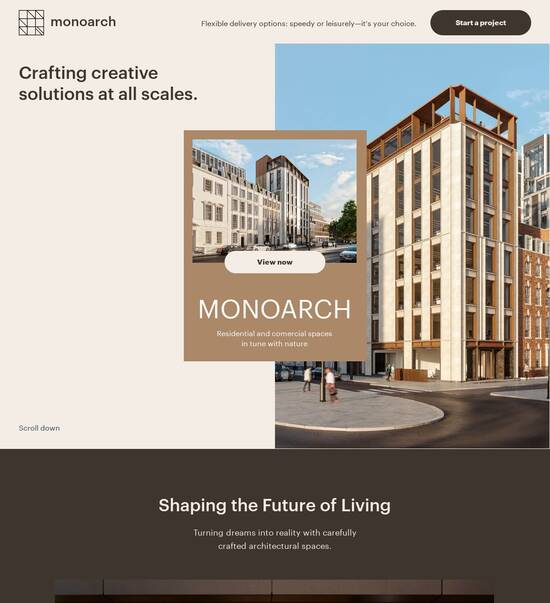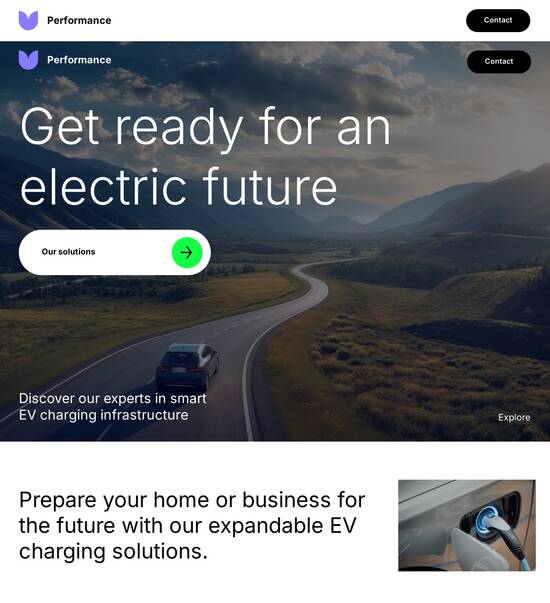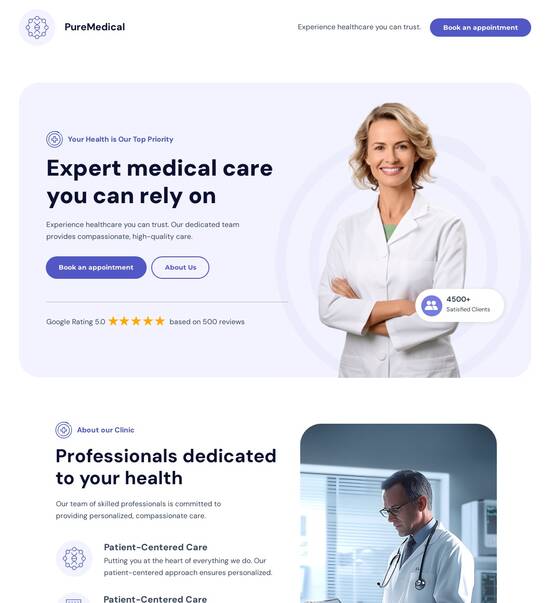
Next.js optimized our brands page template
Explore Similar TemplatesAbout template
Supercharge your our brands page with Next.js for outstanding performance! Learn more today.
Recommended templates

Easy to build without coding
With the intuitive drag-and-drop builder, anyone on your team can create high-converting pages without any knowledge of code or design. Make enhancements to your landing page with custom widgets using Javascript, HTML/CSS, or third-party scripts.

Multiple layouts for any industry and goal
Select from 500+ landing page layouts built to boost conversions across industry-specific scenarios. Customize them by adjusting fonts, adding images, and generating on-brand content with the AI assistant. Quickly scale with Instablocks® and Global Blocks that you can save, reuse, and update globally.

Loads fast and looks polished on any device
Every template is responsive, which means they present professionally on any device and load blazingly fast with our Thor Render Engine. You can also power them up with Google AMP technology to deliver an unparalleled mobile experience and drive higher conversions.

Robust analytics & experimentation
Get real-time updates and reporting across all your devices, showing the number of visitors, conversions, cost-per-visitor, and cost-per-lead. Launch AI-powered experiments, run A/B tests, and use heatmaps to analyze user behavior, then optimize your landing page to maximize conversions.







Easy to build without coding
With the intuitive drag-and-drop builder, anyone on your team can create high-converting pages without any knowledge of code or design. Make enhancements to your landing page with custom widgets using Javascript, HTML/CSS, or third-party scripts.
Multiple layouts for any industry and goal
Select from 500+ landing page layouts built to boost conversions across industry-specific scenarios. Customize them by adjusting fonts, adding images, and generating on-brand content with the AI assistant. Quickly scale with Instablocks® and Global Blocks that you can save, reuse, and update globally.
Loads fast and looks polished on any device
Every template is responsive, which means they present professionally on any device and load blazingly fast with our Thor Render Engine.
Robust analytics & experimentation
Get real-time updates and reporting across all your devices, showing the number of visitors, conversions, cost-per-visitor, and cost-per-lead. Launch AI-powered experiments, run A/B tests, and use heatmaps to analyze user behavior, then optimize your landing page to maximize conversions.
All the features you need to build lead-generating landing pages
Explore more featuresLearn how to build top-performing landing pages for any goal
FAQs
Leading the way in building high-performing landing pages





A step-by-step guide to using Instapage for optimal landing page creation
Instapage stands out as the most robust landing page and conversion rate optimization (CRO) platform available. Whether you are a seasoned marketer or new to the digital landscape, this comprehensive tool provides everything needed to accelerate, optimize, scale, and maximize the return on investment (ROI) of your marketing campaigns.
Understanding the importance of landing pages
Landing pages are crucial in converting visitors into leads or customers. With Instapage, you can leverage over 100 high-converting templates in business services, marketing and advertising, tech/SaaS, education, energy & utilities, financial services, government, and insurance sectors. This versatility allows for tailored content that resonates with the specific interests of your target audience.
- High-conversion templates: Instapage offers pre-built layouts that allow for rapid deployment of effective landing pages tailored to industry needs.
- User-friendly interface: Creating pages without tech knowledge is simple with intuitive drag-and-drop features to enhance the user experience.
- Optimized for conversion: Incorporate A/B testing and real-time analytics to constantly improve performance based on visitor behavior.
Step 1: Selecting the right template
Start by choosing a template that aligns with your campaign goals. Instapage provides a range of customizable options tailored for different industries, ensuring that you can find the perfect fit for your offer or service.
Step 2: Customizing your landing page
Upon selecting a template, tailor it to your brand’s voice by modifying text, colors, images, and layouts. A well-branded page helps in establishing trust and relevance with your visitors.
- Add personalized elements: Include dynamic content relevant to your audience to significantly improve engagement.
- Utilize video or graphics: High-quality visuals can improve your compelling narrative and enhance the overall aesthetic of the landing page.
- Implement clear call-to-action buttons: Ensure that your buttons are visually distinct and use actionable language to encourage clicks.
Step 3: Optimize for performance
Once you've built and customized your landing page, it's time to optimize it for conversions. Use Instapage’s built-in tools like heatmaps and analytics to see how users interact with your page.
- Conduct A/B testing: Experiment with different versions of your landing pages to discover what resonates best with your audience.
- Analyze visitor data: Understanding where visitors are clicking and dropping off allows for targeted optimizations.
- Adjust for mobile responsiveness: Ensure your landing page performs well on all devices, as a significant portion of users accesses web content through smartphones.
With these steps, you are well on your way to creating high-performance landing pages that can significantly enhance your marketing effectiveness.
Don't hesitate to dive into Instapage today, create landing pages that convert, and elevate your digital marketing strategy. Start your free trial now and witness the difference.
People also ask about Next.js optimized our brands page template
Unveiling the Power of Next.js in Optimizing Brand Page Templates
Harnessing Next.js for enhanced brand presence
Next.js is a powerful React framework that enables developers to create fast and user-friendly web applications. Its significance in modern web development cannot be overstated, as it streamlines the process of building dynamic, feature-rich websites. For brands, having a well-optimized page template is crucial in establishing a solid digital identity and enhancing customer engagement. A thoughtfully designed brand page not only showcases essential information but also reflects the brand's values and image.
Brand page templates play a pivotal role in how potential customers interact with a business online. They serve as the first impression, setting the tone for user expectations, engagement, and conversion rates. With Next.js, businesses can leverage cutting-edge technology to create responsive and fast-loading pages that captivate visitors and encourage them to explore further.
Core features of Next.js for brand page optimization
Next.js offers several key features that enhance the optimization of brand pages. By implementing server-side rendering (SSR), brands can ensure their pages load rapidly while improving search engine optimization (SEO). SSR allows the server to render the page before sending it to the client, leading to quicker load times and ultimately a better user experience.
Static Site Generation (SSG) is another powerful feature of Next.js that pre-renders the pages at build time. This approach provides faster performance, as visitors receive fully rendered HTML rather than waiting for JavaScript to execute. Many brands, such as those in eCommerce, utilize SSG to display product pages and content, improving their SEO and loading speeds significantly.
Dynamic routing is another standout feature that allows brands to create flexible routes tailored to their audiences. This capability ensures that content delivery meets the specific needs of each user. For example, a fashion brand can create dynamic routes based on user preferences or geographic locations, enhancing the overall consumer experience.
Crafting a template that engages and converts
Creating an engaging template requires a careful balance between customizability and brand identity. Brands need templates that are adaptable enough to accommodate unique content while maintaining consistent branding elements that reinforce recognition and trust. Next.js allows for high levels of customization, making it easier for marketers to create a robust online presence that resonates with their target audience.
Moreover, adherence to accessibility standards is crucial in today's digital landscape. Google emphasizes the importance of web accessibility, as it not only enhances brand perception but also builds user trust. Next.js templates are designed with accessibility in mind, ensuring that all users, regardless of their abilities, can engage with brand content.
Integrating cutting-edge technologies
The evolution of web development means brands must integrate advanced technologies to remain competitive. Next.js supports API routes, allowing for efficient data fetching and processing requests seamlessly. This functionality enhances user experience by enabling asynchronous loading and interactive elements that keep visitors engaged on the page.
Additionally, the compatibility with headless content management systems (CMS) such as Contentful and Sanity makes it easy for brands to manage their content without interrupting the user experience. Marketers can scale their content and make updates without worrying about the technical aspects of the site, resulting in a more agile content strategy.
Optimizing user experience with location-based features
In an effort to personalize content and improve engagement, utilizing location data is essential. Next.js allows for geo-targeted content delivery, enabling brands to serve users relevant information based on their geographic location. For example, a local restaurant can present region-specific menus, events, or promotions that resonate better with its audience.
This level of personalization can significantly increase user interaction, leading to higher conversion rates. By tailoring content to individual visitors, brands foster a sense of connection, encouraging consumers to engage more deeply with the brand.
Building collaborative teams around brand page development
For successful brand page development, fostering a collaborative environment among cross-functional teams is crucial. Marketers, developers, and designers should work together to ensure their vision aligns with the brand's identity and goals. Strategies for effective collaboration include regular check-ins, shared project management tools, and clear communication channels.
Implementing feedback loops also aids in continuous improvement; collecting insights from team members during different phases of development ensures the final product aligns with expectations and objectives. This collaborative approach not only streamlines the project but also enhances creativity and innovation in the development of brand page templates.
Streamlining content management and delivery
One of the key components of an effective brand page is efficient content management. Next.js provides various content fetching strategies, such as getStaticProps and getServerSideProps, enabling brands to optimize content delivery effectively. GetStaticProps is best used for static pages where data doesn’t change frequently, as it generates pages at build time. In contrast, getServerSideProps is ideal for dynamic content, where data may vary frequently, ensuring users receive the latest content during their interactions.
Additionally, handling content updates and integrating with external sources is simplified in a Next.js environment. By setting up automated workflows, brands can ensure that their content remains fresh and relevant, significantly enhancing user satisfaction.
Q&A: Tackling common questions about Next.js optimization
As brands consider adopting Next.js, several common questions often arise. Key concerns include the learning curve associated with the framework and the resources necessary to implement it effectively. While venturing into a new technology can be challenging, the extensive and supportive community around Next.js can provide valuable assistance. Furthermore, potential pitfalls, such as performance issues or improper content fetching strategies, can be addressed with best practices and careful planning. Brands that utilize Next.js have reported significant improvements in performance and user engagement, showcasing its capability in driving digital success.
Enhancing DNS and domain management for brand pages
Managing custom domains is vital for brand identity and web presence. Optimizing domain routing can significantly improve page performance. Best practices include ensuring domain registration aligns with brand parameters, implementing SSL certificates for security, and using a reliable DNS provider that guarantees uptime.
Additionally, setting up a content delivery network (CDN) can enhance page load times for visitors worldwide. This approach ensures that brands maintain an excellent digital experience irrespective of geographical challenges.
Previews and testing: Ensuring perfection before launch
Before launching a brand page, it is crucial to conduct thorough testing across varying devices and browsers. This includes checking accessibility features, page responsiveness, and ensuring consistent performance. Utilizing tools like Lighthouse or GTmetrix can help assess SEO metrics, load times, and overall user experience.
An organized testing phase can unveil potential issues, allowing developers to make necessary adjustments before the official launch. By prioritizing testing, brands position themselves for success, ensuring that every user interaction aligns with their goals.
Engaging with developer communities and resources
Engaging with the vibrant Next.js community can provide immense value to brands venturing into optimization. Numerous forums, local meetups, and online resources are available for developers and marketers alike. Platforms like GitHub, Dev.to, and Stack Overflow are excellent for exchanging ideas, troubleshooting problems, and sharing innovative practices.
Collaborating with the community not only fosters growth but also inspires brands to leverage shared learning experiences to improve their brand pages continuously. Networking within these communities can further empower brands to stay current with trends and developments in web technologies.
The future of brand page optimization with Next.js
Looking ahead, the future of brand page optimization with Next.js appears promising. Emerging trends such as increased focus on performance, security, and personalization are shaping the roadmap for Next.js development. As web standards evolve, brands that adopt Next.js will likely have the advantage in delivering high-quality and flexible web experiences.
Insights into the integration of artificial intelligence and machine learning within Next.js pose exciting possibilities for brands, enabling hyper-personalized user experiences. A steady evolution in technology will continue to influence branding strategies and eCommerce, positioning Next.js as a strong pillar in the domain of website optimization.
Appendix
This section includes a glossary of key terms related to Next.js and brand optimization to aid understanding for new developers and marketers exploring this terrain.
Next.js
A React framework designed for building applications with server-side rendering and static site generation.
SSR
Server-side rendering, a method of generating pages at runtime on the server.
SSG
Static site generation, generating pages beforehand at build time for faster load times.
API Routes
Built-in feature in Next.js to enable serverless functions and retrieve data for pages.
Headless CMS
A content management system that separates content storage from its delivery.
Ready to skyrocket conversions?
Supercharge your ad campaigns with high-performing landing pages
Get started














